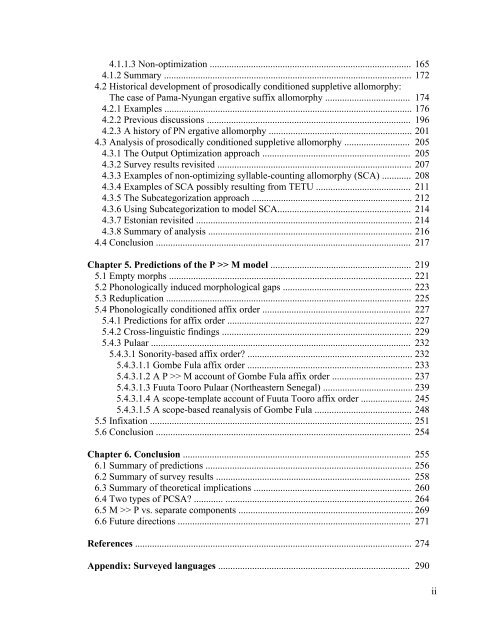Phonological Conditions on Affixation
Phonological Conditions on Affixation
Phonological Conditions on Affixation
You also want an ePaper? Increase the reach of your titles
YUMPU automatically turns print PDFs into web optimized ePapers that Google loves.
4.1.1.3 N<strong>on</strong>-optimizati<strong>on</strong> ................................................................................... 165<br />
4.1.2 Summary ...................................................................................................... 172<br />
4.2 Historical development of prosodically c<strong>on</strong>diti<strong>on</strong>ed suppletive allomorphy:<br />
The case of Pama-Nyungan ergative suffix allomorphy ................................... 174<br />
4.2.1 Examples ...................................................................................................... 176<br />
4.2.2 Previous discussi<strong>on</strong>s .................................................................................... 196<br />
4.2.3 A history of PN ergative allomorphy ........................................................... 201<br />
4.3 Analysis of prosodically c<strong>on</strong>diti<strong>on</strong>ed suppletive allomorphy ........................... 205<br />
4.3.1 The Output Optimizati<strong>on</strong> approach ............................................................. 205<br />
4.3.2 Survey results revisited ................................................................................ 207<br />
4.3.3 Examples of n<strong>on</strong>-optimizing syllable-counting allomorphy (SCA) ............ 208<br />
4.3.4 Examples of SCA possibly resulting from TETU ....................................... 211<br />
4.3.5 The Subcategorizati<strong>on</strong> approach .................................................................. 212<br />
4.3.6 Using Subcategorizati<strong>on</strong> to model SCA....................................................... 214<br />
4.3.7 Est<strong>on</strong>ian revisited ......................................................................................... 214<br />
4.3.8 Summary of analysis .................................................................................... 216<br />
4.4 C<strong>on</strong>clusi<strong>on</strong> ......................................................................................................... 217<br />
Chapter 5. Predicti<strong>on</strong>s of the P >> M model .......................................................... 219<br />
5.1 Empty morphs .................................................................................................... 221<br />
5.2 <str<strong>on</strong>g>Ph<strong>on</strong>ological</str<strong>on</strong>g>ly induced morphological gaps ..................................................... 223<br />
5.3 Reduplicati<strong>on</strong> ..................................................................................................... 225<br />
5.4 <str<strong>on</strong>g>Ph<strong>on</strong>ological</str<strong>on</strong>g>ly c<strong>on</strong>diti<strong>on</strong>ed affix order ............................................................. 227<br />
5.4.1 Predicti<strong>on</strong>s for affix order ............................................................................ 227<br />
5.4.2 Cross-linguistic findings .............................................................................. 229<br />
5.4.3 Pulaar ........................................................................................................... 232<br />
5.4.3.1 S<strong>on</strong>ority-based affix order? .................................................................... 232<br />
5.4.3.1.1 Gombe Fula affix order .................................................................... 233<br />
5.4.3.1.2 A P >> M account of Gombe Fula affix order ................................. 237<br />
5.4.3.1.3 Fuuta Tooro Pulaar (Northeastern Senegal) ..................................... 239<br />
5.4.3.1.4 A scope-template account of Fuuta Tooro affix order ..................... 245<br />
5.4.3.1.5 A scope-based reanalysis of Gombe Fula ........................................ 248<br />
5.5 Infixati<strong>on</strong> ............................................................................................................ 251<br />
5.6 C<strong>on</strong>clusi<strong>on</strong> ......................................................................................................... 254<br />
Chapter 6. C<strong>on</strong>clusi<strong>on</strong> .............................................................................................. 255<br />
6.1 Summary of predicti<strong>on</strong>s ..................................................................................... 256<br />
6.2 Summary of survey results ................................................................................ 258<br />
6.3 Summary of theoretical implicati<strong>on</strong>s ................................................................. 260<br />
6.4 Two types of PCSA? ............ ............................................................................. 264<br />
6.5 M >> P vs. separate comp<strong>on</strong>ents ........................................................................ 269<br />
6.6 Future directi<strong>on</strong>s ................................................................................................ 271<br />
References .................................................................................................................. 274<br />
Appendix: Surveyed languages ............................................................................... 290<br />
ii

















